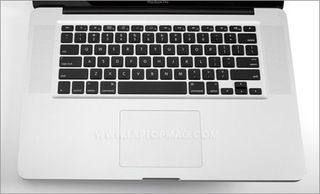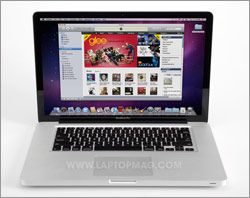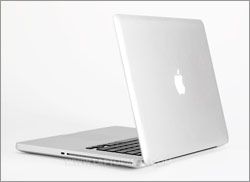Laptop Mag Verdict
The latest version of Apple's 15-inch dream machine delivers Core i7 power and automatic switchable graphics while lasting nearly 8 hours on a charge.
Pros
- +
Excellent battery life
- +
Strong Core i7 performance
- +
Automatic switchable graphics
- +
Comfortable backlit keyboard
- +
Great touchpad with inertial scrolling
Cons
- -
Runs warm
- -
Limited ports
- -
Pricey
Why you can trust Laptop Mag
Nearly a year has passed since Apple released its updated 15-inch MacBook Pro, featuring a unibody aluminum construction, SD Card slot, and a longer-lasting lithium ion battery. Now, the Cupertino-based company has incorporated a few important upgrades under the hood to supercharge this elegant machine (starting at $1,799; $2,199 as configured). These enhancements include the long-awaited Intel Core i7 processor, capable of overclocking on the fly, and automatic graphics-switching technology that makes moving from integrated to discrete graphics mode all but invisible to the user. Best of all, even with the jump from Core 2 Duo to Core i7, Apple has managed to deliver all-day battery life. These are collectively welcome improvements, but are they enough to justify the premium? Yup.
Design
The 15-inch MacBook Pro sports the same carved-from-a-single-chunk-of-metal unibody design as its brethren, with a sturdy aluminum chassis and rounded edges. The overall look is classy and modern, though it makes upgrading individual components (like the RAM and hard drive) more difficult, as the entire bottom must be unscrewed.
The MacBook Pro has the same dimensions as before (14.4 x 9.8 x 1 inches), but it weighs a slightly heavier 5.6 pounds. While we definitely felt the extra heft while carrying the machine home, it did fit in our messenger bag, which is more than we can say about most 15-inch notebooks. The only system that comes close is the HP Envy 15, which has an equally slim and stylish profile (15.0 x 9.6 x 1 inches) and weighs a lighter 5.2 pounds. Regardless, this notebook will take up your entire tray table if you take it on a flight.
Heat
The 15-inch MacBook Pro held up well during our heat test, where we play a Hulu video at full screen for 15 minutes; the space between the G and H keys remained a balmy 84 degrees Fahrenheit, and the touchpad measured just 71 degrees. However, the back rear bottom of the notebook reached an uncomfortable 104 degrees. Also, after using the system on our lap for an hour and typing this review while watching another Hulu video, the middle of the underside increased to a hot 105 degrees. Moreover, while running the World of Warcraft test, we could hear the fan from 10 feet away. Still, the HP Envy 15 was even hotter, reaching 110 degrees near the vent.
Keyboard and Touchpad
Similar to other MacBook Pros, our unit featured a shallow keyboard with black, isolated keys that provided solid feedback when typing URLs and writing documents. The keys are backlit, a feature that can be activated manually or by the ambient light sensor, which will illuminate the keys when typing in low-light situations (such as a darkened plane cabin). While typing in a dark room, the soft glow enabled us to see the keys clearly.
Apple was the first company to introduce mouse buttons integrated into the touchpad itself, and while others have imitated it, Apple's touchpad still remains the best. Not only is it huge--4.1 x 3 inches--but we never saw the cursor jump around, as with some Dell and HP touchpads, even when using two hands.
Of course, multitouch functionality is built in, and Apple has added an extra feature called inertial scrolling. When you use two fingers to scroll down a document, it keeps scrolling for a bit even after you've completed the finger swipe; this makes it easier to scroll though large documents.

Click to enlarge
Display and Audio
As usual, we loved the bright and crisp 15.6-inch display on the MacBook Pro. Its resolution of 1440 x 900 pixels is adequate, though we suspect many photographers and other creative pros will opt for the 1680 x 1050-pixel option. While reflections from the glossy display weren't overwhelming, it's also nice to know there's an antiglare option--though only for the higher resolution display. Still, colors were bright, blacks were deep and dark, and viewing angles were excellent both vertically and horizontally.
Speakers on either side of the keyboard provided very good audio. At full volume, the Black Eyed Peas' "I Gotta Feelin'" filled a small room; higher tones were crisp without sounding distorted, and lower notes, such as the bass line in the song, had enough presence without being overwhelming.
Ports and Webcam
On the right side of the 15-inch MacBook Pro you'll find the 8X SuperDrive and Kensington lock slot. Built into the left side are two closely placed USB 2.0 ports, Mini DisplayPort, a FireWire 800 port, the MagSafe power port, and headphone and mic jacks. Conspicuous in its absence: an ExpressCard slot, found on the original 15-inch MacBook Pro (and on the current 17-inch MacBook Pro), which is replaced by an SD Card slot. For the money, we would've liked to seen at least one more USB port and HDMI.

Click to enlarge
The webcam above the display was excellent in a Skype video chat. The other caller said that he could make out objects in the background, as well as the stitching on our all-black sweater. The embedded microphone also picked up our voice well.
Performance

Click to enlargeLike other systems we've tested with the Intel Core i7-620M processor, the MacBook Pro returned superb results, especially considering it was paired with 4GB of RAM. After installing Windows 7, we ran PCMark Vantage in Boot Camp, and saw a score of 6,699; that's nearly double the mainstream average of 3,885, not to mention the previous 15-inch MacBook Pro's score of 3,285 (which used a 2.66-GHz Intel Core 2 Duo processor and 4GB of RAM). The HP Envy 15, which uses a 1.6-GHz Intel Core i7-720QM processor and 6GB of RAM, came in about 500 points lower, at 6,173. However, the Sony Vaio Z, which had a 2.4-GHz Core i5-520M processor, scored a much higher 9,936 (though that system had dual SSDs).
Multitasking on this MacBook Pro was a breeze; we had about a dozen windows open in Safari, including Google Docs and streaming music from Pandora, and were able to easily pan around lower Manhattan in Google Earth. 3D Buildings rendered in about 5 seconds, and flying around the city was smooth.
Booting into Mac OS X 10.6 took the 500GB hard drive a speedy 44 seconds, but loading Windows 7 was a somewhat slower 1 minute and 25 seconds. We saw the same difference when duplicating a 4.97GB folder of multimedia: in the Mac OS, it took 2:45 (30.8 MBps), whereas in Windows it took 4:20 (19.6 MBps). Still, there are some benefits to operating in Boot Camp; we transcoded a 114MB MPEG-4 to AVI using Oxelon Media Encoder in just 47 seconds, a new record.
Graphics
Like the previous generation of MacBook Pros, this model also features switchable graphics with the integrated Intel GMA HD and discrete Nvidia GeForce GT 330M chip. The older MacBook Pro had an Nvidia GeForce 9400M as its integrated card, and a GeForce 9600M GT (with 256MB of memory) as its discrete GPU.
However, users no longer have to log out or suffer through a few seconds delay while the notebook switches chips; the changeover is now seamless and instantaneous. Unlike Nvidia's Optimus technology, which routes everything through the integrated GPU (but produces the same result), Apple's method shuts off the GPU that's not in use. In this manner, Apple claims better battery life while still delivering more horsepower when needed. When software senses that an application is using graphics frameworks such as Core Graphics, OpenGL, or Quartz Composer, it will turn on the discrete GPU. Users can also disable automatic switchable graphics in the Energy Saver control panel, but doing so will cause the discrete GPU to stay on at all times.
On 3DMark06 (running in Boot Camp), the discrete Nvidia GPU scored 6,746, double the category average and 800 points above the older 15-inch MacBook Pro. However, it was outperformed by the HP Envy 15 (7,236), which uses an ATI Mobility Radeon HD 4830 GPU and 1GB of video memory, and the Acer Aspire 5740G (7,166), which has an ATI Radeon HD 5650 GPU and 1GB of VRAM. The ASUS U30Jc-1A, which has similar switchable graphics but a less powerful Nvidia 310M graphics chip, notched just 3,711.
Of course, with a 3DMark06 score exceeding 6,500, the MacBook Pro's gaming performance is nothing to sneeze at. With graphics set to maximum and the screen resolution at native, the machine notched 69 frames per second in World of Warcraft; similar settings in Far Cry 2 produced a somewhat lackluster 24 fps. While that's about 10 fps higher than the previous MacBook Pro, it's about 10 fps below that of the Acer Aspire 5740G. It should be noted that both tests were run in Boot Camp, and that gamers should experience better performance in a Mac environment.
In a few anecdotal tests, we didn't see much difference between the new and old MacBook Pros. It took both systems just 6 seconds to open a 417.8MB TIF file in Photoshop CS4. We then used the same liquefy filter on the image, and timed how long it took for the notebooks to apply the change. The newer MacBook Pro finished the job in 2 minutes and 38 seconds, while the older MacBook Pro took just 16 seconds longer. We then imported a 1.66GB MPEG-4 into iMovie; the newer MacBook Pro took 10 minutes and 11 seconds to complete this task, and the older MacBook Pro was just 18 seconds behind it.
Battery Life and Wireless
We never expect stellar battery life out of 15-inch notebooks, yet that's where the MacBook Pro really stands out. On our LAPTOP Battery Test (continuous web surfing over Wi-Fi) the notebook lasted 7 hours and 54 minutes, more than double the category average (3:40), and akin to endurance you'd see on an ultraportable or thin-and-light. Even then, comparable notebooks were found wanting: The Sony Vaio Z lasted just 5:21 on stamina mode, and the ASUS U30Jc gave out after 7:07. While the older MacBook Pro managed 8:06, the endurance on the newer model is all the more impressive when you consider its increased power.
Green Testing

Click to enlargeOwing to its stellar endurance, the MacBook Pro did well on our Battery Efficiency Rating. The notebook recharged completely in 2 hours and 41 minutes, using an average of 42.9 watts during that time. Its rating of 14.6 is even better than that of netbooks (17.5), where lower is better. The notebook also has a strong EPEAT rating of 21 out of 27.
Configurations
While we tested the most expensive preconfigured version, Apple offers three different configurations of the 15-inch MacBook Pro. The base model--if you consider $1,799 a base price--comes with a 2.4-GHz Intel Core i5-540M processor, 4GB of RAM, a 320GB hard drive, and 256MB of video memory. The next tier ($1,999) gets you a 2.53-GHz Intel Core i5 processor, 4GB of RAM, a 500GB hard drive, and 256MB of video memory.
All the models are customizable: users can select up to a 512GB SSD which itself, at $1,300, costs as much as a 13-inch MacBook Pro. A 1680 x 1050 display is $100 extra, and one with an antiglare coating costs $50 on top of that.
Software and Warranty
One of the best value adds that Apple offers is the software package on its systems. The MacBook Pro includes Apple's iLife '09 creativity suite (iPhoto, iMovie, iWeb, and GarageBand), Front Row, Photo Booth, and its Time Machine backup software. While we're glad it doesn't have any trialware on it, we would like to see a word processor that's a little less rudimentary than Notepad.
Apple's standard warranty remains: one-year limited parts-and-labor and 90 days of toll-free, 24/7 phone support (Apple consistently aces our annual Tech Support Showdown). The AppleCare Protection Plan, which includes three years each of parts-and-labor coverage and phone support, costs $249. To see how Apple fared on our Tech Support Showdown, click here.
Verdict
Apple has once again produced a well conceived and well designed notebook that smartly integrates the latest cutting edge technologies in a way that is unique. Not only is the latest 15-inch MacBook Pro powerful, but it lasts a long time on a charge. However, while this machine is among the most portable notebooks with a 15-inch display, 5.6 pounds is a fair amount of weight to carry around. If you care more about portability than endurance, the 13-inch VAIO Z is the better splurge. But if you want a big screen, excellent battery life, and plenty of muscle in a compact package, no other system comes close.
Apple MacBook Pro 15-inch (Core i7) Specs
| Bluetooth | Bluetooth 2.1 |
| Brand | Apple |
| CPU | 2.66-GHz Intel Core i7-620M |
| Card Slots | 2-1 card reader |
| Company Website | http://www.apple.com |
| Display Size | 15.4 |
| Graphics Card | Intel GMA HD (integrated), Nvidia GeForce GT 330M |
| Hard Drive Size | 500GB |
| Hard Drive Speed | 5,400rpm |
| Hard Drive Type | SATA Hard Drive |
| Native Resolution | 1440x900 |
| Operating System | OS X 10.6 (Snow Leopard) |
| Optical Drive | DVD SuperMultiDrive |
| Optical Drive Speed | 8X |
| Ports (excluding USB) | Headphone, Firewire 800, Ethernet, DisplayPort, Microphone |
| RAM | 4GB |
| RAM Upgradable to | 8GB |
| Size | 14.4 x 9.8 x 1.0 inches |
| USB Ports | 2 |
| Video Memory | 512MB |
| Warranty/Support | One-year limited parts-and-labor and 90 days of toll-free, 24/7 |
| Weight | 5.6 pounds |
| Wi-Fi | 802.11b/g/n |
